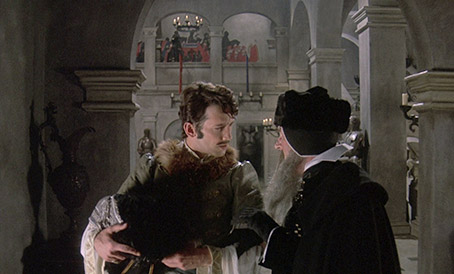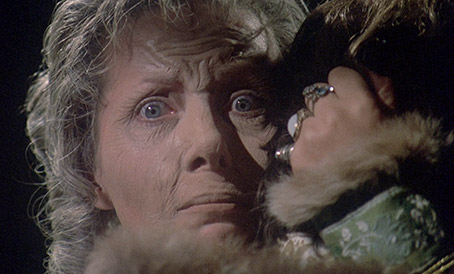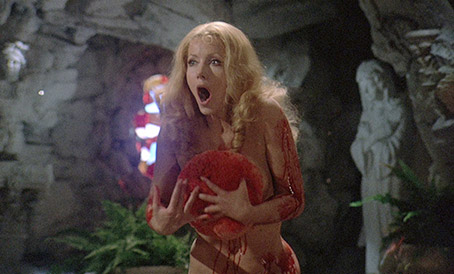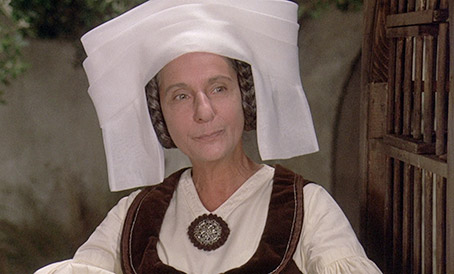|
It's been quite a month for Countess Erzsébet Báthory, or Elizabeth Bathothy as her name tends to be Anglicised. A Hungarian noblewoman who has the dubious honour of being history's most prolific female serial killer, Báthory's last days before her arrest were immortalised by Walerian Borowczyk in the best episode of his 1974 Immoral Tales, which was recently released as a lovely dual format disc by Arrow films. Coincidentally released on the very same day was Network Distributing's Blu-ray of Hammer Films' Countess Dracula, which as far as I'm aware was the first film to be directly inspired by the Báthory legend. I use the term legend deliberately in this case, because while Báthory and her crimes were all too real, their scale and horrific nature (depending on the source, she was responsible for the torture and murder of between 50 and 650 young women) gave birth to a number of questionable fables, the favourite being that she bathed in the blood of the murdered girls in the belief that it would preserve her youth. Just as this provided the most visually striking sequence in Immoral Tales, it also proved the basis for Hammer's more supernatural take on the story.
Here Ingrid Pitt plays the ageing Countess Elisabeth Nádasdy (no randomly chosen pseudonym – Erzsébet was married to Hungarian aristocrat Ferenc Nádasdy), whom we first encounter at her husband's funeral. The Count's death leaves the way clear for Elizabeth and the castle's steward Captain Dobi to finally come clean about their long-standing love affair, but the funeral is also attended by a handsome young officer named Imre Toth, a former friend and comrade of the Count, to whom the far older Elisabeth is immediately attracted.

Frustrated by her fading looks, Elisabeth lashes out at a servant girl and is splashed by her blood, which has an immediate rejuvenating effect on her skin. She subsequently kills the girl and bathes in her blood, and is transformed into the beautiful woman of her youth. She immediately begins to court the attentions of Toth under the guise of her daughter Ilona, whom Dobi has kidnapped on Elisabeth's instructions to prevent her from claiming her half of her father's estate. But the transformative effect of the blood proves to be temporary, and soon Elisabeth, aided by Dobi and her faithful nurse Julie, is procuring more girls for their revitalising bodily fluid.
Countess Dracula was in some ways an unusual film for its day, particularly in light of its position in the Hammer filmography. At a time when a more relaxed approach to censorship was allowing filmmakers to push the boundaries a little on nudity and gore, the film has surprisingly little of either. Not everyone was happy about this on the film's initial release, expressing disappointment at the sparseness of the very elements that a Hammer film with a title like Countess Dracula (which, knowing Hammer, was likely the first thing to be set in stone) would lead you to expect to be there in abundance.
Yet viewed from a modern perspective, it's this restraint that distinguishes the film and has given it an unexpected degree of longevity. There's actually something rather stately about the whole enterprise, and for the most part it plays more like a historical drama with horror overtones than straight-up genre work, with costumes and sets left over from Anne of a Thousand Days giving it a more lavish feel than its budget would otherwise have allowed. A well structured and sometimes literate screenplay by Jeremy Paul, based on a story by director Peter Sasdy and producer Alexander Paal (Hungarians both), provide a solid foundation for Sasdy's thoughtful direction. Both the script and the handling downplay the story's more sensational elements (the body count here is considerably lower than even the most conservative estimate of the real Báthory's victims) and they even hold back on sequences that seem to demand that they lert rip. It's almost as if Sasdy and Paul were concerned that such elements might somehow diminish the quality of their carefully constructed drama. But there is clear purpose here, notably in Sasdy's rationing of the nudity, which pays off when Elisabeth's secret is very nakedly exposed, a moment whose effectiveness stems in part from the fact that this is the only time she is seen in such a state of undress.

The lead actors are similarly committed to treating the project as a dark historical drama with a supernatural twist. The ever-authoritative Nigel Green makes for a splendid Captain Dobi, a man who is denied the woman of his affections but is still so loyal to her that he is willing to aid her determination to retain her recovered youth and even marry a younger man, in spite of the frustration and pain that it causes him. As Imre Toth, Sandor Elès is only really required to look dashing and eagerly snog the young countess, but when the truth about her is revealed, his barely concealed revulsion at what he is blackmailed into participating in is vividly conveyed. As Elisabeth's loyal nurse Julie, respected stage actress Patience Collier plays her role with conviction and pleasing restraint, while Maurice Denham delights as the heavily bearded (there's barely a clean-shaved male face here) and ever so slightly eccentric castle historian, Master Fabio. And yes, that's a 16-year-old Lesley-Anne Down as Elisabeth's daughter Ilona.
But the film rightly belongs to Ingrid Pitt, who for my money turns in her finest ever screen performance here as Countess Elisabeth Nádasdy. Did I say performance? My apologies. Pitt gives two very distinct performances, one as Elisabeth Nádasdy the bitter old woman, the other as Elisabeth Nádasdy the beautiful young seductress. So completely does she immerse herself in the role of the ageing Countess, and so convincing is her body language, her facial expressions and Tom Smith's make-up, that if you didn't know in advance and stepped into the film midway, you'd swear they were played by two different performers.
There's a Jekyll and Hyde undercurrent to this generational switch, but Sasdy resists the temptation to show the transformation and instead has Elisabeth return to her older self in the blink of an edit and a change of camera angle, the regression caught each time in reflection on a surface that in some way distorts her face, expressionistically capturing how Elisabeth sees herself. Like a diabolical gift that requires payment in kind, every time the effect of the blood wears off, Elisabeth has aged a few more years, the decay of her body matched by a corresponding deterioration of her mental state.

It's been a long time since I last saw Countess Dracula. I always remember having a soft spot for it, but coming back to it after so many years, particularly looking as good as it does here (more on that below), was something of a revelation. Without wishing to sound even a tad disparaging about a studio whose work I hold in the highest esteem, there's a maturity, restraint and commitment to quality here that not only makes Countess Dracula a distinctive film in the Hammer oeuvre, but marks it as one of the studio's finest late period works.
Framed in its original aspect ratio of 1.66:1, this is a generally handsome HD transfer. While not reference quality sharp, the picture detail still outstrips Network's own 2006 DVD release by a very visible margin, and there is plenty in the production design and costumes (not to mention the male facial fair) to show this off. The colour tends to have an earthy bias, but intermittently brighter colours do break through and are attractively rendered, particularly the bright red of the restorative blood and the vivid blue in the glass panels in the folding screen in Elisabeth's room. Film grain is visible but not obviously enhanced and the image itself is generally clean of dust spots and damage. On the whole this is a very pleasing job. There are, however, two or three occasions where the image quality substantially drops and the grain jumps up to almost night vision levels. The effect is confined to single shots within an otherwise unblemished sequence, and could well be the result damaged shots being replaced by those from an inferior quality print during the restoration process.
The Linear PCM mono 2.0 track is clear and free of damage, and while lacking the bass punch of the Dolby years to come, it shows no sign of over-crisp trebles, and music is well handled throughout.
Optional English subtitles for the hearing impaired are included.
Audio commentary with Ingrid Pitt, Kim Newman and Stephen Jones
A commentary ported over from Network's 2006 DVD release, on which the venerable Messrs Jones and Newman are joined by Ingrid Pitt for an enjoyable and intermittently revealing look back at the film and its making. Initially I found myself quietly wishing that Jones and Newman had recorded their own track in addition to playing host to the enthusiastic Ingrid, as sharing the talk time reduces their always knowledgeable input. But as the commentary progressed I found myself happy with the chosen approach, in part because I began to suspect that Mr. Newman is not quite as fond of the film as Mr. Jones, whose opinions I found myself sharing at every turn, but also because their conversations with Ms. Pitt prompt their share of revealing responses. I was intrigued to learn, for example, that having recorded a spoken sequence as Báthory for a track by English metal band Cradle of Filth, she disassociated herself from the work after an extreme element of the band's stage act recalled behaviour she had witnessed during her time in a Nazi concentration camp. She also has no time for director Peter Sasdy ("He was no help at all and I hate him and I don't want to talk about him"), but is happy to reveal that she couldn't wait to take her clothes off for the camera, and on seeing herself nude delightedly purrs, "Oh yes, my beautiful body. Oh God, it's so yummy!"

Theatrical Trailer (2:57)
A windowboxed trailer with a rhyming narration that describes the film as 'Hammer's Horrific Historic Masterpiece'. Not a bad job, as it happens.
Archive Interview with Ingrid Pitt (6:33)
One of those daytime TV interviews that makes you want to slap the chirpy interviewer, who asks the expected "and what was he like to work with?" type questions and refers to Hammer Films as 'Hammer House', though at the end does suggest she'd rather like to go home with our Ingrid (whoops). Pitt herself briefly touches on her work for Hammer and filming Where Eagles Dare, and, more interestingly, her battle with breast cancer and why she and her family were sent to a Nazi concentration camp.
50 Years of Hammer: News Feature (1:57)
A short and typically superficial Meridian News piece on the 50th anniversary of Hammer Films. Includes a brief bit with Ingrid Pitt signing autographs and ends with reporter Malcolm Stewart trying to be witty by saying "fangs for the memory". Idiot.
Thriller: Where the Action Is (64:19)
An episode from season 4 of the 70s UK TV series Thriller in which Ingrid Pitt co-stars as Ilse, the companion of super-rich professional gambler 'Daddy' Burns. We meet him in the opening scene, where he takes a high-stakes stud poker game to its ultimate conclusion, which results in the death of his esteemed opponent. A short while later, carefree gambler Eddie Vallance is picked up and drugged by Ilse and wakes to find himself trapped in Burns' country house. Here he is given some serious stake money and pressured into playing a series of casino games for the amusement of his host, which are set to culminate in a game of stud poker that will ask Vallance to make the ultimate bet. A really well devised mystery thriller with a sprinkling of neat twists, the episode was written by Brian Clemens and directed by Don Leaver, both of whom made their name previously on The Avengers. Although shot on analogue video, the transfer here is first rate.

Conceptions of Murder: Peter and Maria (25:04)
A single episode from the 6-part 1970 London Weekend Television series Conceptions of Murder, in which Nigel Green plays true life German serial killer Peter Kürten, the so-called 'Vampire of Düsseldorf', who committed a series of murders and sexual assaults in 1929. The episode focuses on the evening when Kürten reveals his crimes to his wife (played by Yootha Joyce) and is a chillingly well written and handled showcase for Green's considerable talents. Again in fine shape, although there's clearly an issue with one of the studio cameras.
Production Image Gallery (9:27)
A rolling gallery of high quality promotional stills, mostly monochrome but with a few in colour.
Behind the Scenes Image Gallery (7:00)
Another rolling gallery, this time of behind-the scenes photos, all of them monochrome.
Portrait Image Gallery (6:18)
Posed promotional photos of the main cast, a mix of colour and black-and-white pics. Unsurprisingly, there are plenty of Ingrid.
Promotional Image Gallery (2:27)
A number of posters and front-of-house stills. Several include a misleading tagline that suggests Báthory improves her looks by drinking the blood rather than bathing in it.
Commemorative Booklet
This was not available for review.
A too often undervalued late period Hammer, an historical drama that earns its horror credentials by taking the most famous Báthory fable at its word. It always puzzled me that Hammer never made any play of the potentially marketable notion that the film was based on historical fact – you'll find it nowhere on the film or the promotional material. Then again, this particular sales gimmick never really took off until posters for The Texas Chainsaw Massacre assured us "It happened!" (it actually didn't, at least not like it was portrayed in the film). Network has really done the film proud here, with a solid transfer and an excellent set of special features. For the Hammer fans particularly, highly recommended.
|